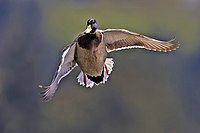New strain of Bird Flu appears in China
Wednesday, November 1, 2006
A new strain of Avian Flu or Bird Flu has been discovered in China and has also infected some humans. The virus also "spreads fast" and has covered a "big geographic region" according to Chinese health officials.
It is not known how dangerous the new virus is and whether it is stronger or deadlier than the current H5N1 virus. Despite being detected in humans, no evidence has turned up to suggest that the virus can be spread easily from human to human.
"The new variant doesn't indicate any increased risk for people other than the fact it seems to be pretty widespread," said World Health Organization's [WHO] Global Influenza Program, which is located in Zurich, Switzerland, Doctor Michael L. Perdue.
"This virus seemed to spread very fast over a big geographic region. However, we don't have any evidence to show whether this virus is more dangerous or less dangerous than any other H5N1 viruses," said State Key Laboratory of Emerging Infectious Diseases at the University of Hong Kong in China director, Yi Guan.
The strain was discovered during April and June of 2006 in China's Fujian Province when Guan's team examined ducks, chickens, geese and other birds at a market in the province. At least 95% of the birds Guan and his team looked at were infected with the new strain and vaccines formulated to fight the H5N1 virus have not worked.
"This novel variant may have become dominant ... because it was not as easily affected as other strains by the avian vaccine used to prevent H5 infection. This [means] that H5 avian vaccines are not able to prevent infection by this virus as efficiently as they do with other types of H5N1," added Guan.
The team is continuing surveillance on the area where the strain was discovered and according to Guan the virus "is not causing widespread infection outside of our surveillance area" but the new strain is reported in Thailand, Laos, Hong Kong and Malaysia.
Scientists also say that current vaccines used in birds for the H5N1 virus might have caused the new strain to develop.
Sources
edit- Brian Handwerk. "New Bird Flu Strain Spreads Fast, Is Resistant to Vaccine" — National Geographic, November 1, 2006
- "Earlier bird flu vaccine 'causes new strain'" — Electric New Paper, October 31, 2006
